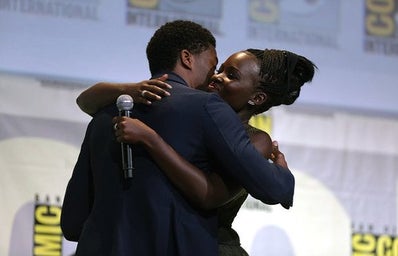Black Panther, directed by Ryan Coogler, tells the story of T’Challa, a prince who returns home to Wakanda in the wake of his father’s death to ascend the throne as King. T’Challa embarks on a typical Marvel hero’s journey and is challenged by N’Jadaka, also known as Erik Killmonger. Ultimately, T’Challa’s biggest battle is deciding if he should continue with the isolationist ways of his ancestors or forge a new legacy for Wakanda. The film utilizes symbolism and breathtaking cinematography to examine contrasting concepts such as militant vs. peaceful liberation methods, bring them into dialogue, and highlight their complexities. Its vibrant and elaborate color palette, paired with fast-paced action scenes, a polyrhythmic soundtrack, and incredibly nuanced social commentary, leaves an indelible impression.
After rewatching this film more times than I can remember, here are the observations and connections I’ve made!
Duality is a recurring theme
Tradition vs. Technological Innovation
The motif of tradition versus technological innovation is etched symbolically throughout Black Panther’s framework. At the start of the film, the camera pans across the landscape of Wakanda. Its lush green plains, picturesque sunsets, and mountains conjure an idyllic African nation untouched by the ills of western colonization. The camera then reveals an Afro-futuristic nation that combines its cultural African aesthetic with futuristic technological innovations. The juxtaposition of thatched Wakandan architecture and technologically advanced infrastructure hints at the weaving of traditional and progressive values into the political and social fabric of Wakanda and its people.
Okoye, a member of the Dora Milaje, an elite group of female warriors who serve as Wakanda’s special forces, and Nakia, a member of Wakanda’s War Dogs, an elite espionage group, are two characters who exemplify this duality. Okoye is eminently traditional; she refuses to adopt western weapons or standards of beauty and is steadfast in her devotion to the throne. Nakia is more progressive, willing to travel the world as a spy, and adapt to different cultures. This essence is captured in the scene following N’Jadaka’s “victory” in the fight for the throne when Nakia attempts to convince Okoye to accompany her to overthrow N’Jadaka. The camera pans back and forth between the two ladies, whose clasped outstretched hands connect and separate them. Their connected hands symbolize their shared love for Wakanda. On the other hand, the distance between them demonstrates their disparate approaches to serving their country. The shifts between Nakia and Okoye create a point of contention. Should Okoye remain loyal to the throne? T’Challa? An ideology? Nakia eventually leaves Okoye, whereas Okoye remains steadfast in her traditional beliefs and loyalty to the throne.
Nature vs. Nurture; T’Challa and N’Jadaka
The contrast between T’Challa and N’Jadaka is not good versus evil; instead, it brings the nature vs. nurture concepts into play and emphasizes the psychological effects of oppression. While the villain is typically a foil to the protagonist in most Marvel films, N’Jadaka’s story is more complicated than a typical villain. His violent upbringing shapes his personality. T’Chaka, T’Challa’s father, killed N’Jadaka’s father, robbing him of any meaningful connection to his home, and as a result, he lives on the defensive. T’Challa, on the other hand, is the product of a supportive and empowering community. The contrasts in experiences perhaps serves as a metaphor for the African vs. African-American experience of race and identity. T’Challa’s identity is defined by his Wakandan nationality, whereas N’Jadaka’s blackness is at the forefront of his identity. When T’Challa visits his ancestral plane, he is greeted by his ancestors, whereas N’Jadaka is only greeted by his father in his Oakland home.
Militant vs. Non-violent approach to liberation
T’Challa and N’Jadaka represent two distinct liberation strategies. T’Challa embodies MLK’s nonviolent approach, whereas N’Jadaka embodies Malcolm X’s militant approach. N’Jadaka sets ablaze the purple-heart herb when he “wins” the first battle for the throne. The fire symbolizes his aggression, desire for vengeance, and anguish in this scene. N’Jadaka’s rage is all-consuming, and, like fire, it is only destructive. The final confrontation between the two exemplifies the clash between nonviolent and militant liberation strategies. While the nonviolent approach prevails, it is not pure; it comes at the cost of other people’s sacrifices and deaths.
Isolationism vs. Interventionism
Moreover, Black Panther raises questions about the developed nations’ responsibilities to underdeveloped countries. At the beginning of the film, a Wakandan aircraft departs Oakland, as children look up in bemusement. The elevated aircraft represents how inaccessible Wakanda is to the rest of the world. Despite its vast resources, Wakanda remains hidden and isolated from everyone. Wakanda asserts that its isolationist policies shield them from the dangers and intrusions of the outside world. Nakia and W’Kabi, the border tribe’s leader, challenge King T’Chaka’s isolationist policies. Ironically, Wakanda only changes its isolationist policies after it encounters external threats.
When T’Challa first visits his ancestral plane, he embraces his father’s isolationist policies. When he arrives, he sees his ancestors sprawled across a tree as panthers. Purple, blue, and black hues overwhelm the sky, and a dark but comforting glow creates a mystical effect. This imagery demonstrates that T’Challa views his ancestors as wise, supernatural beings who can provide him with strength and guidance. T’Challa later returns to his ancestral plane, realizing the consequences of his ancestor’s decision to remain isolated. As evidenced by how the ancestral plane appears differently the second time around, T’Challa’s perception of his ancestral plane shifts dramatically. This scene marks a turning point in the film, as T’Challa abandons his isolationist policies in favor of a more progressive ideology. T’Challa ultimately decides to share Wakanda’s gifts with the world. He returns his aircraft to N’Jadaka’s old Oakland neighborhood and parks it on the ground, where enthused children can access it. The aircraft represents Waknada’s efforts to increase its accessibility to external communities.
Colors and Symbolism
Black Panther has subtexts of black liberation and empowerment, and it does so through the use of symbolism and colors. For example, the colors red, black, and green are repeated; Dora Milaje wears red, black is worn by the black panther, and Nakia wears green. These are the colors of the Pan-African flag, which symbolizes black people’s liberation.
The film Black Panther redefines the markers of a modernized society and tells a story layered with subtle symbolism, cultural references, and remarkable cinematography that lends nuance and depth to its characters and their narratives. It is a beautifully crafted film that leaves lasting impressions. Years after its release, Black Panther remains one of my favorite films.
Can’t get enough of HC UMass Amherst? Be sure to follow us on Instagram, listen to us on Spotify, like us on Facebook, and read our latest Tweets!




